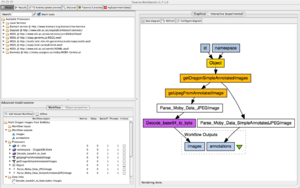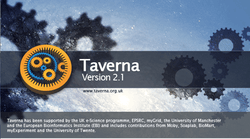Taverna workbench
 | |
 Taverna Workbench | |
| Developer(s) | myGrid |
|---|---|
| Stable release | 2.4 / May 4, 2012 |
| Development status | Active |
| Written in | Java |
| Operating system | Linux, Mac OS X, Microsoft Windows |
| License | LGPL |
| Website | www.taverna.org.uk |
Taverna Workbench provides a desktop authoring environment and enactment engine for scientific workflows. The Taverna workflow enactment engine is also available separately, as a command line tool or as a server.
Taverna is used by users in many domains, such as bioinformatics,[9][10] cheminformatics,[11] medicine, astronomy,[12] social science, music, and digital preservation.[13]
Some of the services for the use in Taverna workflows can be discovered through the BioCatalogue - a public, centralised and curated registry of Life Science Web services. Taverna workflows can also be shared with other people through the myExperiment social web site for scientists. BioCatalogue and myExperiment are another two product from the myGrid consortium.
Taverna is used in over 350 organizations around the world, both academic and commercial. As of 2011, there have been over 80,000 downloads of Taverna across different versions.
Capabilities
Taverna workflows can invoke general SOAP/WSDL or REST Web services, and more specific SADI, BioMart, BioMoby and SoapLab Web services. It can also invoke R statistical services, local Java code, external tools on remote machines (via ssh), do XPath and other text manipulation, import a spreadsheet and include sub-workflows.
Taverna Workbench includes the ability to monitor the running of a workflow and to examine the provenance of the data produced. The provenance system for Taverna is being co-ordinated with the Open Provenance Model.
Taverna includes the ability to search for services described in BioCatalogue to include within workflows. However, services do not need to be described within BioCatalogue to be included in workflows.
Taverna also includes the capability to search for workflows on myExperiment. You can download, modify and run the workflows discovered on myExperiment from within the Taverna Workbench. You can also upload your workflows from the Workbench to myExperiment in order to share them with others.
Taverna workflows do not need to be executed within the Taverna Workbench. Workflows can also be run by:
- a command line execution tool
- remote execution server that allow Taverna workflows to be run on other machines, on computational grids, clouds, from Web pages and portals
- online workflow designer and enactor OnlineHPC
Taverna 2 (the second generation of the Taverna software) allows pipelining and streaming of data. This means that services downstream a workflow can start as soon as the first piece of data is received, without waiting for the whole piece of data to become available. It also has improved memory usage allowing the handling of much larger data sets.

Extensibility
Taverna allows developers to plugin new functionality and also to use Taverna within their own products. Taverna has been extended to allow additional components within workflows, for example those from the Chemistry Development Kit, SADI semantic Web services, and caGrid. It has also been bundled with other products, for example the Taverna-LC plugin for OpenOffice Calc allows calling services as spreadsheet functions.
Various projects and institutions have run Taverna workflows on grids or have used Taverna to access services on grids, such as KnowARC, NGS (National Grid Service), EGEE (Enabling Grids for E-sciencE) and caGrid.
External tools can be included within Taverna workflows either scripts such as Java Beanshell, though the use of an API Consumer service that generates services for the methods exposed by the tool written in Java or via external tools plugin, which allows users to run tools on a grid or remote/local machine using grid or ssh authentication.
External links
References
- ↑ Belhajjame, K.; Wolstencroft, K.; Corcho, O.; Oinn, T.; Tanoh, F.; William, A.; Goble, C. (2008). Metadata Management in the Taverna Workflow System. pp. 651–656. doi:10.1109/CCGRID.2008.17.
- ↑ Li, P.; Castrillo, J. I.; Velarde, G.; Wassink, I.; Soiland-Reyes, S.; Owen, S.; Withers, D.; Oinn, T.; Pocock, M. R.; Goble, C. A.; Oliver, S. G.; Kell, D. B. (2008). "Performing statistical analyses on quantitative data in Taverna workflows: An example using R and maxdBrowse to identify differentially-expressed genes from microarray data". BMC Bioinformatics 9: 334. doi:10.1186/1471-2105-9-334. PMC 2528018. PMID 18687127.
- ↑ Oinn, T.; Addis, M.; Ferris, J.; Marvin, D.; Senger, M.; Greenwood, M.; Carver, T.; Glover, K.; Pocock, M. R.; Wipat, A.; Li, P. (2004). "Taverna: A tool for the composition and enactment of bioinformatics workflows". Bioinformatics 20 (17): 3045–3054. doi:10.1093/bioinformatics/bth361. PMID 15201187.
- ↑ Oinn, T.; Greenwood, M.; Addis, M.; Alpdemir, M. N.; Ferris, J.; Glover, K.; Goble, C.; Goderis, A.; Hull, D.; Marvin, D.; Li, P.; Lord, P.; Pocock, M. R.; Senger, M.; Stevens, R.; Wipat, A.; Wroe, C. (2006). "Taverna: Lessons in creating a workflow environment for the life sciences". Concurrency and Computation: Practice and Experience 18 (10): 1067–1100. doi:10.1002/cpe.993.
- ↑ Hull, D.; Wolstencroft, K.; Stevens, R.; Goble, C. A.; Pocock, M. R.; Li, P.; Oinn, T. (2006). "Taverna: A tool for building and running workflows of services". Nucleic Acids Research 34 (Web Server issue): W729–W732. doi:10.1093/nar/gkl320. PMC 1538887. PMID 16845108.
- ↑ Kawas, E.; Senger, M.; Wilkinson, M. D. (2006). "BioMoby extensions to the Taverna workflow management and enactment software". BMC Bioinformatics 7: 523. doi:10.1186/1471-2105-7-523. PMC 1693925. PMID 17137515.
- ↑ Sroka, J.; Kaczor, G.; Tyszkiewicz, J.; Kierzek, A. (2006). "XQTav: An XQuery processor for Taverna environment". Bioinformatics 22 (10): 1280–1281. doi:10.1093/bioinformatics/btl101. PMID 16551662.
- ↑ Wolstencroft, K.; Haines, R.; Fellows, D.; Williams, A.; Withers, D.; Owen, S.; Soiland-Reyes, S.; Dunlop, I.; Nenadic, A.; Fisher, P.; Bhagat, J.; Belhajjame, K.; Bacall, F.; Hardisty, A.; Nieva De La Hidalga, A.; Balcazar Vargas, M. P.; Sufi, S.; Goble, C. (2013). "The Taverna workflow suite: Designing and executing workflows of Web Services on the desktop, web or in the cloud". Nucleic Acids Research 41 (Web Server issue): W557–W561. doi:10.1093/nar/gkt328. PMC 3692062. PMID 23640334.
- ↑ Stevens, R. D.; Robinson, A. J.; Goble, C. A. (2003). "MyGrid: Personalised bioinformatics on the information grid". Bioinformatics 19: i302–i304. doi:10.1093/bioinformatics/btg1041. PMID 12855473.
- ↑ Stevens, R. D.; Tipney, H. J.; Wroe, C. J.; Oinn, T. M.; Senger, M.; Lord, P. W.; Goble, C. A.; Brass, A.; Tassabehji, M. (2004). "Exploring Williams-Beuren syndrome using myGrid". Bioinformatics 20: i303–i310. doi:10.1093/bioinformatics/bth944. PMID 15262813.
- ↑ Truszkowski, A.; Jayaseelan, K.; Neumann, S.; Willighagen, E. L.; Zielesny, A.; Steinbeck, C. (2011). "New developments on the cheminformatics open workflow environment CDK-Taverna". Journal of Cheminformatics 3: 54. doi:10.1186/1758-2946-3-54. PMC 3292505. PMID 22166170.
- ↑ Hook, R. N.; Romaniello, M.; Ullgrén, M.; Järveläinen, P.; Maisala, S.; Oittinen, T.; Savolainen, V.; Solin, O.; Tyynelä, J.; Peron, M.; Izzo, C.; Licha, T. (2008). "ESO Reflex: A Graphical Workflow Engine for Running Recipes". The 2007 ESO Instrument Calibration Workshop. ESO Astrophysics Symposia European Southern Observatory. p. 169. doi:10.1007/978-3-540-76963-7_23. ISBN 978-3-540-76962-0.
- ↑ Raditsch, M.; Schlarb, S.; Møldrup-Dalum, P.; Medjkoune, L. (2012). "Web content executable workflows for experimental execution".